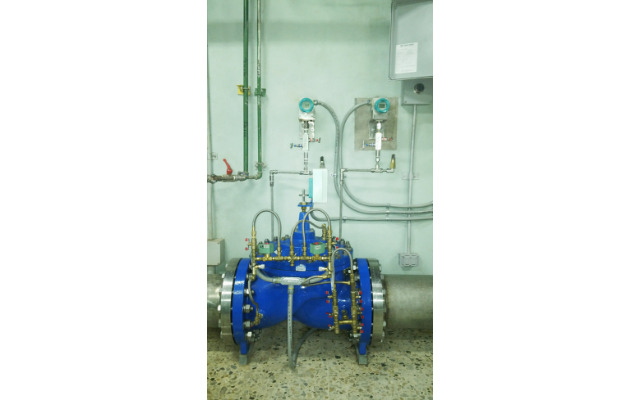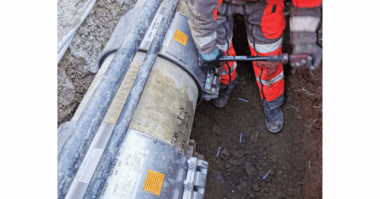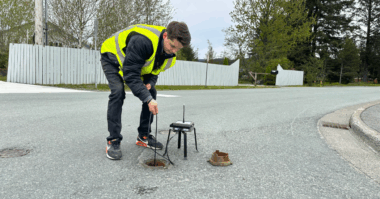The Guadalupe IV Hydroelectric plant is located 70 Km from the of city Medellin, Antioquia and provides electricity to the surrounding areas of Medellin, Envigado and Guadalupe. It has power generation capacity of 216 MW and a net capacity of 202 MW. There are three Francis Vertical Shaft Turbines, with two of the units generating 67 MW and one unit generating 68 MW. This power plant delivers 1,205 GWh per year, with a net generation of 1,026 GWh per year to the Columbian Power Network.
The cooling system for the three turbines collects water from a 235.3 cubic meter holding tank. This water has already been used by the turbines and has fine sand particles so it needs to filter through screens (1mm openings) before it is used for cooling. If any sand comes into contact with the turbine bearings, it can be a big problem. The sand is essentially decanted in the bottom of the tank and can get up to 30 cm high in a period of 6 months with normal operation. This gradually decreases the efficiency of the cooling system due to obstructions caused by the suction of sludge.
The Hydroelectric plant was faced with suspending the operation of generators for a period of up to two days, because of the rudimentary drainage systems to remove the sludge at the bottom of the tank.
Santiago Ramirez and Carlos Ospina designed a sludge removal system that would not only do a better job, but significantly reduce the downtime of power generating operations. They did this by designing a network of high pressure sprinklers that are installed on the bottom of the tank and are fed with pressurized water. The high pressure sprinklers stir the sludge in the bottom slab of the cooling tank, and through a submersible pump they discharge the muddy water into the river at one side of the powerhouse.
To ensure the pressurized water into the tank flows at a constant 150 l/s (2,377.50 USGPM), they needed to install a control valve to regulate the flow. The inlet for the pressurized water comes through a 2″ stainless steel pipe (AISI 304) installed upstream of the intake valves of the generators. This gives a static pressure of 40 bar (580 Psi) that feeds into a 6″ main pipe feeding into a grid of 110 PVC high pressure sprinklers in the bottom of the tank. With a stable flow of 150 l/s (2,377.5 USGPM) and a stable pressure of 40 Bar the 110 sprinklers are able to stir up the sludge for removal from the bottom of the tank.
The Singer 10″- 206 – 2SC – MV – Class 300 control valve was chosen because it combines precise flow control with flow metering to ensure that the flow is adjusted to supply 150 l/s (2,377.5 USGPM) of water at stable pressure. This hydraulically operated valve introduces or releases water from the control chamber above the diaphragm to effectively maintain accurate water control. The metering valve (MV) calculates the flow rate through the valve using a proprietary algorithm, the position of the valve and the pressure differential across the valve. The calculated flow rate can be used as a feedback value to the controller to automatically manage the flow control.
The installation of the sludge extraction system involved assembling the ejectors grid in the bottom of the tank and then connecting the whole system to the flow control valve. The control valve was installed on the top of the tank, leaving a straight stainless steel pipe stub upstream with a length of four times of the valve’s flange size to ensure the flow across the valve is stable. The Hydroelectric plant needed to shut down for 5 days to complete the installation.
The sludge removal is now performed approximately every six months. The plant is only out of service for six hours to prevent the stirred solids from being pumped into the cooling system. The operation consists of lowering the water level of the cooling tank, starting the submersible pumps and operating the flow control valve to initiate the agitation of the decanted solids before discharging into the river.
With the commissioning of the sludge extraction system several benefits were achieved; it has changed from a manual cleaning process using approximately ten people to an automatic process with only four people, cleaning the tank use to take 26 hours and now it only takes 6 hours and downtimes of the generators for maintenance has been reduced as the quality of the water in the cooling system has significantly improved.
Carlos Ospina, Operations Director for Guadalupe Hydroelectric Plant said, “By regulating the flow with the Singer control valve in our new sludge extraction system, we have reduced our maintenance costs and reduced necessary interruption time of power generation. We are very pleased with this outcome and the stability performance of the valve.”
The cooling tank is also connected to the plant’s firefighting system, so having this guaranteed water pressure from the control valve for a high a high demand situation, is a vital safety requirement for the plant.




